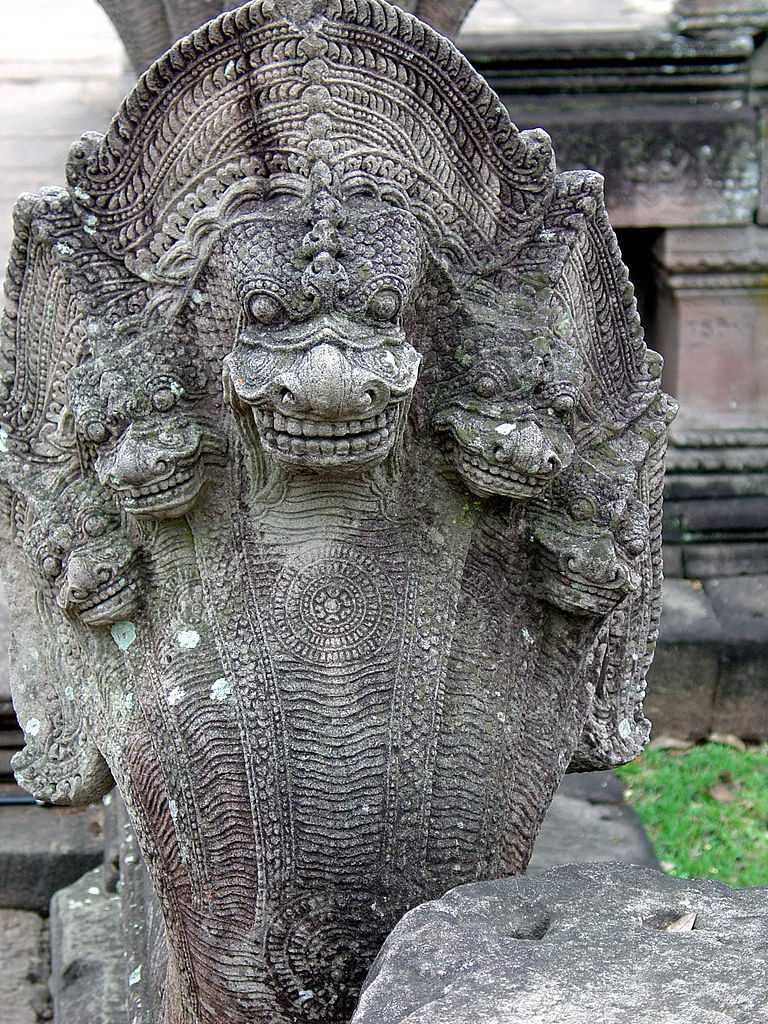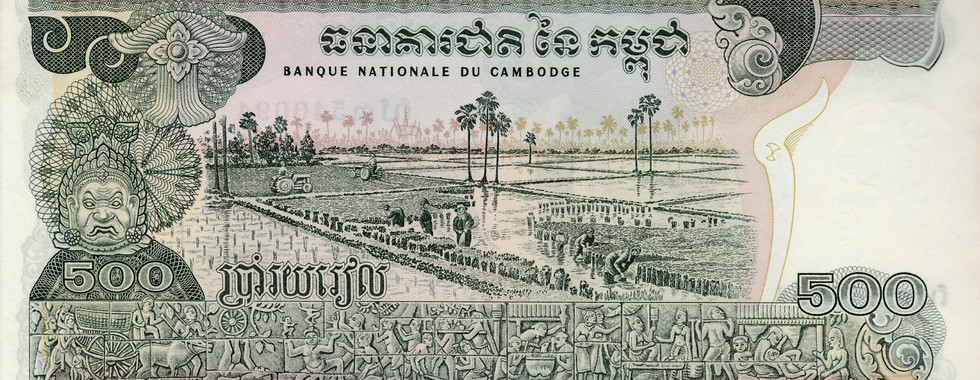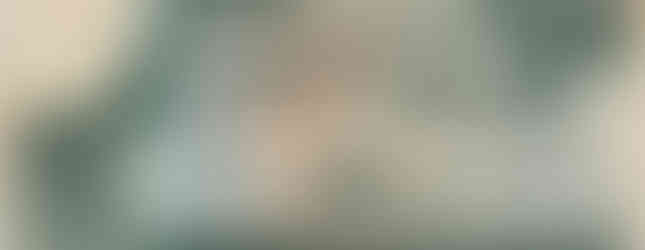This Cambodian banknote represents the 2nd denomination of the First Riel (Fifth Issue, 1972). The First Rial was the currency of (early) post-colonial Laos. It replaced the French Indochinese Piastre, at par (1:1) in 1953. The Riel was initially divided into 100 Centimes. In 1959, the Centime was renamed to Sen.
The 500 Riel was first issued in 1973 and were withdrawn in 1974. They were to be replaced by the Democratic Kampuchea Riel (Series 1975). Which themselves were withdrawn and destroyed, due to the Khmer Rouge abolishing the concept of currency. As being a vestige of capitalism and thus were outlawed. The (Second) Riel was reintroduced on 1 April 1980, after the Vietnamese counter-invasion of Cambodia, in 1978.
Observe

The observe features a Khmer village girl carrying a water vase. Opposite of her is a statue of a Nāga (Buddhist serpent deity). The village girl serves as the note's main art, positioned center-left. While the Nāga to the far right, rests on overlapping guilloché patterns. The Nāga is depicted in the style of ancient Khmer stone reliefs.
Featuring the intricate details and ornate abstract stylizations. For which the Khmer people are world renowned. These bold serpentine patterns be seen throughout Khmer architecture and stone work. Cambodia's unique stone work can be primary seen in the nation's elaborate temples. Whose style heavily draw inspiration from the great rock-cut temple of India.
The observe's text is printed entirely in Khmer script, a local evolution of South Indian Pallava script.
Khmer numerals are featured at the observe's upper corners, expressed as “៥០០" (500). The upper-right "500", rests on a large guilloché pattern. Additional Khmer script is printed on several areas on the observe. At the note's center is the text ប្រាំរយរៀល, or "Five Hundred Riels", on the center engraving. Above is the text "ធនាគារជាតិនៃកម្ពុជា, or the "National Bank of Cambodia".
While not explicitly printed, the note was produced by world famous printer De La Rue, London. A keen eye will noticed the note's hued underprint and patterns. Which were a hallmark for De La Rue notes during the period, such as the Peruvian Sol De Oro. The underprint features the note's value "៥០០" and Khmer stone carvings. There is a security guilloché pattern behind the village girl and twin serial numbers. Twin diagonal serial numbers were another De La Rue feature, of the era. The note's serial number reads, "ស៣540094".
Reverse

The reverse depicts a rice farm and reliefs, taken from Angkor Wat temple. It's center (main art) prominently depicts a rice paddy, during planting season. Farmers can be seen planting rice plant, while tractors work in the background. Above and to the lower left of the main art, is bilingual text printed in French and Khmer. The upper text translates to “National Bank of Cambodia”. While the lower text states the note's value, “Five Hundred Riels”.
The note's 500 Riel value is repeated in both standard numerals. Located on the left and right of the main arts lower corners. Above the left "500" is a relief of Garuda (a divine eagle/man), on a guilloché background. While the unprinted space above the right "500", serve as a watermark area. The watermark a Khmer man in right-profile. Just forward of the watermark area is a negative for the observe's registration element/light puzzle. When backlit a stylized Khmer carving appears.

The Serpent Deity

The Nāga are a race of semi-divine to divine half-human serpent being, from Patala-loka (the nether realm). They are revered in the religions of Hinduism, Buddhism, and Jainism. They're said be created by Kashyapa (an ancient Saptarishi sage) and Kadru (Mother of the Nagas). They have been worship in South Asia for at least 2,000 years.
Some Nāgas are said to display shape-shifting abilities. Being able to transform to full serpent and occasionally human form. Living in an enchanted underworld, filled with gold, gems, and other earthly treasures. Giving them the association as being guardians of treasure and thus are depicted outside temples. In the Buddhist tradition, they guard the Dēvas (demigods) of Trāyastriṃśa from attacking Asura (antigods).
Despite their powerful venom, they often are featured in benevolent roles. Such as Vasuki (King of Sārpas), companion to Lord Shiva (God of Destruction). Vasuki is often depicted as adorned around the Supreme God's neck, like a necklace.
Vasuki plays a prominent role in the Samudra Manthana, creating the Amrita (nectar of immortality). By allowing himself to be bound upon Mount Mandara, as a rope. Which the Dēvas and Asura (after being coxed by Lord Shiva) pull upon.As the Dēvas and Asura pulled, their equal power (positive/negative energy), lead to the churning of Mount Mandara.
Which laid at the center of Kshirasāgara (the ocean of milk), representing the cosmos. During the act, Vasuki accidently dropped his dangerous venom, threating creation. Which was quickly consumed by the immortal Shiva. Narrowly saving the realms of Dēva, Asura, and Manuṣya (human-realm). Thus forever marking the immortal god with his iconic blue skin.
This link to the cosmic sea, may be the origin of many cultures associating Nāgas, with bodies of water. Ranging from the simple village well, rivers, and the open sea. Buddhist tradition splits Nāgas into water-dwellers and earth-dwellers. Water-dwellers live amongst rivers, streams, and seas. While earth-dwellers, live amongst the caves and abandoned tunnels.
In addition, types of Nāgas can be associated by their number of heads. There are two forms of low-caste Nāgas, the single-headed and 3-headed forms. A single-headed Nāga, symbolically represents when all is lost, the Nāga will victory and happiness to all. They serve as guardians for temples, shrines, and imperial residences.
This is opposed to Kalyak (3-headed Nāgas), which are often depicted as evil. They are created between the realms of Dēva and Manuṣya. Serving as treasure guardians, at the bottom of the sea. Their heads represent multiple meanings, primarily the high gods Visnu (God of Preservation), Shiva, and Brahma (God of Creation). But also the realms of Dēva (heaven), Manuṣya (earth), and Norok (hell). Alternatively in Buddhist tradition, the heads symbolize Buddha (center), the concept of Dharma (right), and the Bhikkhu monkhood (left).
These lower-caste are followed by 3 upper-castes, of immortal Nāgas. The first being Anontak (5-headed Nāgas), created from the elements of the Earth. Their 5 heads symbolize the cardinal direction north, south, east, west, and center (the self).
Alternatively in Buddhist tradition, the heads symbolize the 5 manifestations of the Buddha. As Kadabak, Kunsontho, Koneakumno, Gautama Buddha and Seare Metrey. The Anontak are amongst the most common Nāgas depicted at temples, in Indochina.
The Anontak are followed by the Muchlentak (7-headed Nāgas), among the most symbolically important of the Nāga castes. Which are said to originate from beneath the Himalayas. They are revered as bringers of peace and prosperity to humanity.
In Buddhist tradition they are said to have sheltered Gautama Buddha's mortal form, for 7 days and nights. They are often carved as guardians, along the causeways leading to major temples. Such the great Khmer Temple of Angkor Wat. Their heads symbolize the 7 colors of the rainbow and the days of the week.
The Supreme Nāga is known as Vasukak (Vasuki), is an immortal celestial serpent. Who bares 9 heads and serves as companion to Supreme God/Lord Shiva. When used a double-sided temple carving, the forward symbolizes reincarnation, while the rear represents death. Vasukak's 9 heads symbolize the 9 immortals being of the cosmos. In addition, each individual head has power over a particular aspect. Such as an element (rain/lighting/fire), spirits, wealth, order and destruction. The center head holds the power of Brahma, creation and preservation.

These number of heads often defines what "race" a Nāga belongs to. Primitive Nāgas lack the ability to shapeshift and can spit fire, like European dragons. Spiritual Nāgas are treasure guardians, such as the Kalyak. Who can only shift to a half-human form, due to their low caste. While Divine Nagās can take a full human form and travel across realms. The highest form are Supreme Nagās, such as Vasuki. Who have the power to control nature and alter aspects of reality itself.
Ultraviolet Gallery


Size Comparison

Fifth Issue Riel Gallery
(Gallery will be updated as more banknotes are databased)
Additional Notes
This note's dimensions are 183 × 86 mm or 7.20 x 3.39 in, making it a relatively large.
It's advisable to use large protective sleeves, when preserving this note.
All non-currency related photos are public domain images, provided by Wikimedia.
The First Riel was the last Cambodian currency to feature French text.
The village girl carrying a water vase, is a reference to the Nāga association with water.
The note's Nāga is a Anontak, representing the 5 manifestations of the Buddha.
The term Nāga is derived from the Sanskrit word for "serpent".
Nāgas are regarded as Garuda's enemies, thus he perpetually punishes them.
In Hinduism Garuda serves as mount of Lord Vishnu and the personification of courage.
Garuda is depicted on the note's reverse, in his hybrid man/eagle form.
Some representation of Garuda, depict him in his full eagle form.

















Comments